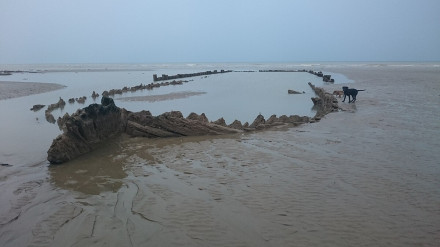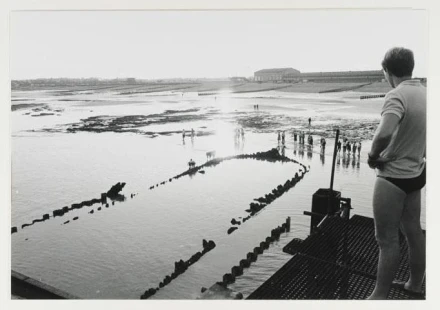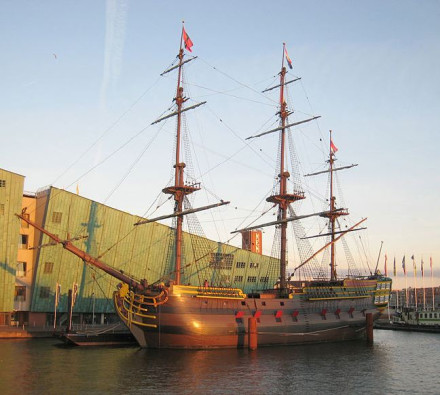History
The Amsterdam was a Dutch East India Company ship that was lost during her maiden voyage from Holland to The East Indies (Batavia). She left Texel on January 8, 1749. Due to bad weather and headwinds she had to anchor at the Downs (UK).
Storm
On January 11, De Amsterdam was hit by a heavy southwesterly storm that lasted for days. The Amsterdam struggled for days against the wind to reach the English Channel. Meanwhile, five men a day were dying from exhaustion, disease and cold. The Amsterdam finally had to abandon her efforts on January 23 and enter Pevensey Bay, near Hastings.
There the rudder was broken on a sandbank. The ship, now rudderless, dropped anchor and lay there for several days, pitching and tossing wildly.
On Sunday, January 26, skipper Klump decided to beach the ship in order to save the ship, passengers and cargo. He succeeded in this effort. The crew soldiers and passengers and twenty-eight cash boxes (worth 300,000 guilders) could be saved.

Salvage attempts
Looters attacked the ship almost immediately. After several days of looting, the situation was brought under control by English troops. Over the next three weeks, the VOC made frantic efforts to save the ship. On March 11, 1749, the VOC gave up all attempts to save the cargo. The Amsterdam sank further and remains there to this day.
Discovery
The presence of the great wreck near Hastings was always remembered. The identity of the ship was only (again) established in 1969 when the wreck became visible again at extremely low tide.
Cargo and inventory
Many objects have been excavated: wine bottles, textiles and other organic materials, ceramics and even a book. An anchor of the Amsterdam, is now on display at St. Katharine Docks in London.

Research and conservation
The VOC Ship Amsterdam Foundation conducted archaeological research on the wreck in 1984, 1985 and 1986. A plan was also made on how best to protect the wreck. For example, a frame of steel beams was placed to serve as a breakwater. The steel beam structure was removed again in October 1999 because there were fears that it would damage the wreck. In 2002, an attempt was made to pack the shipwreck with sand rolls. In 2018, the 'Docking the Amsterdam' plan was launched to raise the shipwreck in its entirety.(1)
Description
Built: on the VOC wharf in Amsterdam in 1748.
Armament: 54 canons
Replica
A replica of De Amsterdam was built between 1982 and 1990 by 400 volunteers from the Amsterdam Bouwt Oostindiëvaarder Foundation (SABO). This replica has been located at the jetty of the Maritime Museum in Amsterdam, the former 's Lands Zeemagazijn, since 1990.

| Skipper | Willem Klump |
|---|---|
| People on board | 300 |
| Length | 150 Amsterdam feet (42.5 m) |
| Tonnage | 1150 ton (575 last) |
Status
References
- National Heritage List for England.
Amsterdam on Historic England. - J.H.G. Gawronski (ed) (1987).
Jaarrapport van de Stichting VOC schip Amsterdam.
Haarlem, H.J.W. Becht. - Amsterdam (schip,_1748).
- NL-HaNA_1.04.02_5262_0036.
Betaalrol Amsterdam.